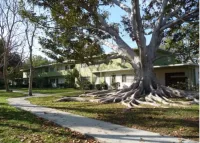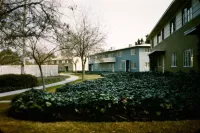Share what you know,
and discover more.
Share what you know,
and discover more.
Mar 07, 2022

-

- Charmaine Bantugan
The Village Green
The Village Green (formerly called Baldwin Hills Village) is recognized worldwide as a pivotal and progressive experiment in multiple-family housing. The Village Green has been lauded as "one of a handful of projects that stands out as a fundamental advance in both planning and architecture." It is the only garden apartment complex in California designated as a National Historic Landmark, the highest level of recognition bestowed by the National Park Service. Prestigious honors notwithstanding, the success of this experiment in multi-family housing still resonates today among its residents and admirers, who enjoy its spacious, light-filled units and park-like grounds. They regularly hold concerts on the green and outdoor movies in this "oasis of pedestrian calm." HISTORY: Completed in 1942, Baldwin Hills Village (now The Village Green) is the product of an all-star design team that included Reginald D. Johnson, Lewis E. Wilson, Edwin E. Merrill, Robert E. Alexander, Clarence S. Stein, and landscape architect Fred Barlow, Jr. Its designers looked to Garden City planning principles in its design and development. Residential buildings face central greens (the largest is about 800 feet wide), and many feature patio or balcony areas, blurring the line between outdoor and indoor living space. Automobiles are relegated to garage courts, and common laundry areas are situated between buildings, all of which facilitate resident interaction and the use of common areas for recreation and play. Spacious units are cleverly situated within outwardly simple, but high-quality residential structures to make use of natural light and cross-ventilation, reducing the cost of construction and, later, utilities. Inspired by the romance of “Old California,” the wholly modern landscapes were designed by Fred Barlow, Jr. Original pepper and eucalyptus trees mingled with drought-tolerant olive, sycamore, walnut, and oak, creating elegant, tree-lined allees (an alley in a formal garden bordered by trees or bushes) paved in decomposed granite, which has since been removed. Although a major flood caused by a dam break in the Baldwin Hills caused extensive damage to the complex in 1963, the community has been lovingly preserved and cared for by generations of residents. From 1972 to 1978, Baldwin Hills Village was redeveloped into condominiums and renamed The Village Green. SIGNIFICANCE: The Garden City Movement, though born in late nineteenth-century England in the writings of Ebenezer Howard, was perfected and honed for American cities by Clarence Stein, Henry Wright, and the Regional Planning Association of America. Stein wrote that the purpose of Baldwin Hills Village was "to demonstrate the practical possibilities of spacious homes and surroundings in an orderly community at low rentals," and to use the basic features of garden city planning: the use of the superblock, homes facing central greens – here, twenty acres of green parks – and complete separation of pedestrian and automobile circulation. Stein would later write that the community, with 629 residential units on sixty-eight acres, was the purest expression of these innovative principles. Only fourteen percent of the site is dedicated to residential use, leaving a remarkable amount of green space for patios, recreation areas, and site-specific landscaping. The expanses of open space were planned in response to the oppressive crowding and inhumane conditions of the slums that garden apartments were intended to replace. Yet due to tenant restrictions that were widespread at the time, Baldwin Hills Village allowed only white, middle-class residents in its early years. Photo courtesy Architectural Resources Group
The Village Green
The Village Green (formerly called Baldwin Hills Village) is recognized worldwide as a pivotal and progressive experiment in multiple-family housing. The Village Green has been lauded as "one of a handful of projects that stands out as a fundamental advance in both planning and architecture." It is the only garden apartment complex in California designated as a National Historic Landmark, the highest level of recognition bestowed by the National Park Service. Prestigious honors notwithstanding, the success of this experiment in multi-family housing still resonates today among its residents and admirers, who enjoy its spacious, light-filled units and park-like grounds. They regularly hold concerts on the green and outdoor movies in this "oasis of pedestrian calm." HISTORY: Completed in 1942, Baldwin Hills Village (now The Village Green) is the product of an all-star design team that included Reginald D. Johnson, Lewis E. Wilson, Edwin E. Merrill, Robert E. Alexander, Clarence S. Stein, and landscape architect Fred Barlow, Jr. Its designers looked to Garden City planning principles in its design and development. Residential buildings face central greens (the largest is about 800 feet wide), and many feature patio or balcony areas, blurring the line between outdoor and indoor living space. Automobiles are relegated to garage courts, and common laundry areas are situated between buildings, all of which facilitate resident interaction and the use of common areas for recreation and play. Spacious units are cleverly situated within outwardly simple, but high-quality residential structures to make use of natural light and cross-ventilation, reducing the cost of construction and, later, utilities. Inspired by the romance of “Old California,” the wholly modern landscapes were designed by Fred Barlow, Jr. Original pepper and eucalyptus trees mingled with drought-tolerant olive, sycamore, walnut, and oak, creating elegant, tree-lined allees (an alley in a formal garden bordered by trees or bushes) paved in decomposed granite, which has since been removed. Although a major flood caused by a dam break in the Baldwin Hills caused extensive damage to the complex in 1963, the community has been lovingly preserved and cared for by generations of residents. From 1972 to 1978, Baldwin Hills Village was redeveloped into condominiums and renamed The Village Green. SIGNIFICANCE: The Garden City Movement, though born in late nineteenth-century England in the writings of Ebenezer Howard, was perfected and honed for American cities by Clarence Stein, Henry Wright, and the Regional Planning Association of America. Stein wrote that the purpose of Baldwin Hills Village was "to demonstrate the practical possibilities of spacious homes and surroundings in an orderly community at low rentals," and to use the basic features of garden city planning: the use of the superblock, homes facing central greens – here, twenty acres of green parks – and complete separation of pedestrian and automobile circulation. Stein would later write that the community, with 629 residential units on sixty-eight acres, was the purest expression of these innovative principles. Only fourteen percent of the site is dedicated to residential use, leaving a remarkable amount of green space for patios, recreation areas, and site-specific landscaping. The expanses of open space were planned in response to the oppressive crowding and inhumane conditions of the slums that garden apartments were intended to replace. Yet due to tenant restrictions that were widespread at the time, Baldwin Hills Village allowed only white, middle-class residents in its early years. Photo courtesy Architectural Resources Group
Mar 07, 2022
The Village Green
The Village Green (formerly called Baldwin Hills Village) is recognized worldwide as a pivotal and progressive experiment in multiple-family housing.The Village Green has been lauded as "one of a handful of projects that stands out as a fundamental advance in both planning and architecture."
It is the only garden apartment complex in California designated as a National Historic Landmark, the highest level of recognition bestowed by the National Park Service.
Prestigious honors notwithstanding, the success of this experiment in multi-family housing still resonates today among its residents and admirers, who enjoy its spacious, light-filled units and park-like grounds. They regularly hold concerts on the green and outdoor movies in this "oasis of pedestrian calm."
HISTORY:
Completed in 1942, Baldwin Hills Village (now The Village Green) is the product of an all-star design team that included Reginald D. Johnson, Lewis E. Wilson, Edwin E. Merrill, Robert E. Alexander, Clarence S. Stein, and landscape architect Fred Barlow, Jr. Its designers looked to Garden City planning principles in its design and development.
Residential buildings face central greens (the largest is about 800 feet wide), and many feature patio or balcony areas, blurring the line between outdoor and indoor living space. Automobiles are relegated to garage courts, and common laundry areas are situated between buildings, all of which facilitate resident interaction and the use of common areas for recreation and play.
Spacious units are cleverly situated within outwardly simple, but high-quality residential structures to make use of natural light and cross-ventilation, reducing the cost of construction and, later, utilities.
Inspired by the romance of “Old California,” the wholly modern landscapes were designed by Fred Barlow, Jr. Original pepper and eucalyptus trees mingled with drought-tolerant olive, sycamore, walnut, and oak, creating elegant, tree-lined allees (an alley in a formal garden bordered by trees or bushes) paved in decomposed granite, which has since been removed.
Although a major flood caused by a dam break in the Baldwin Hills caused extensive damage to the complex in 1963, the community has been lovingly preserved and cared for by generations of residents. From 1972 to 1978, Baldwin Hills Village was redeveloped into condominiums and renamed The Village Green.
SIGNIFICANCE:
The Garden City Movement, though born in late nineteenth-century England in the writings of Ebenezer Howard, was perfected and honed for American cities by Clarence Stein, Henry Wright, and the Regional Planning Association of America.
Stein wrote that the purpose of Baldwin Hills Village was "to demonstrate the practical possibilities of spacious homes and surroundings in an orderly community at low rentals," and to use the basic features of garden city planning: the use of the superblock, homes facing central greens – here, twenty acres of green parks – and complete separation of pedestrian and automobile circulation. Stein would later write that the community, with 629 residential units on sixty-eight acres, was the purest expression of these innovative principles.
Only fourteen percent of the site is dedicated to residential use, leaving a remarkable amount of green space for patios, recreation areas, and site-specific landscaping. The expanses of open space were planned in response to the oppressive crowding and inhumane conditions of the slums that garden apartments were intended to replace. Yet due to tenant restrictions that were widespread at the time, Baldwin Hills Village allowed only white, middle-class residents in its early years.
Photo courtesy Architectural Resources Group
Posted Date
Mar 07, 2022
Historical Record Date
Mar 07, 2022
Source Name
Los Angeles Conservancy
Source Website
Delete Story
Are you sure you want to delete this story?











